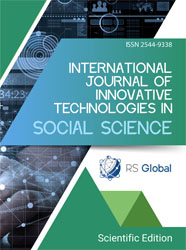DEVELOPMENT OF “UIS” WOVEN LEARNING BASED ON KARO’S CULTURAL VALUES IN VOCATIONAL HIGH SCHOOLS
Abstract
This study aims to develop a learning model of UIS weaving based on the relevant Karo cultural values in schools. The research uses research and development through the Borg and Gall model development approach. The research subjects were the teachers and students of the Vocational School (SMK) Negeri 1 Berastagi where the research was conducted. Data collection techniques using observation and interviews. The data analysis technique used a qualitative descriptive technique. The research findings can be described as follows. First, the relevant Uis Karo weaving learning model used for the cultivation of Karo cultural values is Carl Rogers' version of the nondirective learning model. Second, modification and adjustment of this learning model are carried out so that it can be used to instill Karo's cultural values, especially those related to the format of the lesson plan. Third, teachers can carry out Uis Karo weaving learning using a non-directive model for planting Karo cultural values by the applicable curriculum in schools while still paying attention to the Karo regional government policy regarding the development of a Karo ethnic-based curriculum. The results of the study found that noble values formulated in various expressions need to be given to students, among others; Uis Karo is a culture of the Karo tribe. Uis Karo is a set of traditional clothes used in cultural activities. Uis (cloth) means clothing in Karo so that its development has made uis into various types, styles, and functions. Uis is made from cotton, spun, and woven manually using looms instead of machines. The composition of the yarn as the basic material for Uis uses cotton yarn with natural dyes, but some also use factory fabrics that are dyed with chemical dyes. Some of this uis are rare because they are no longer used in everyday life, or are only used in cultural ritual activities related to animist beliefs and are no longer practiced.
References
Antara Sumut. (2020). YPI: 189 anak jadi korban kekerasan di Sumatera Utara. https://sumut.antaranews.com/berita/268424/ypi-189-anak-jadi-korban-kekrasi-di-sumatera-utara Kamis, 2 Januari 2020 15:17 WIB
Borg, W.R & Gall, M.D. 1983. Edacational Research: An Introduction. New York: Longman.
Budiyono, dkk (2008). Kriya Tekstil untuk SMK, jilid 3. Jakarta: Direktorat Pembinaan Sekolah Menengah Kejuruan. E-book
D. Ampera & N.Juliarti. (2015). Pengaruh Penggunaan Media CD Tutorial Terhadap Hasil Belajar Membatik. https://jurnalteknodik.kemdikbud.go.id
Ekowarni, Endang. 2010. "The Development of Noble Character Values as National Character". Taken from http://belanegarari.wordpress.com/2009/08/25/development-values-noble-character-as-nation-character, on March 26, 2010.
Endang, Ekowarni. (2010). Pengembangan nilai-nilai budi pekerti sebagai karakter bangsa. http://belanegarari.wordpress.com/2009/08/25/pengembangan-nilai-nilai-luhur-budi-pekerti-sebagaikarakter-bangsa. Pada panggal 26 maret 2021
Iswardhani, Nunik and Djukri. 2015. "The Effect of Using Tapioca Waste as a Learning Source on Student Motivation and Learning Outcomes". Cakrawala Pendidikan, Th. XXXIV, No. 1. Joyce, Bruce & Weil, Marsha. 2004. Models of Teaching. Boston: Pearson.
Iswardhani, Nunik and Djukri. 2015. "The Effect of Using Tapioca Waste as a Learning Source on Student Motivation and Learning Outcomes". Cakrawala Pendidikan, Th. XXXIV, No. 1. Joyce, Bruce & Weil, Marsha. 2004. Models of Teaching. Boston: Pearson.
Joyce, Bruce & Weil, Marsha. 2004. Models of Teaching. Boston: Pearson.
Riduwan, (2015). Skala Pengukuran Variabel-variabel Penelitian. Bandung: Alfabeta
Sandra Niessen (2009). Legacy In Cloth, Batak Textile Of Indonesia, Cataloug I. KITLV Press, Leide.n
Sanjaya, Vienna. (2005). Learning in Competency-Based Curriculum Implementation. Jakarta: Prenada Media.
Sinaga, Dearlina. 2016. "Application of the Students Teams Achievement Division Model to Improve Learning Outcomes and Creativity in Economic Learning". Educational Horizons. Th. XXXV. No. 3.
Sitepu (1980). Mengenal Seni Kerajinan Tradisyonal Karo. Medan. Di akses tgl 11 November 2019, pukul 08.00
Situmeang. (2012). Analisis Semiotika Kain Uis Peninggalan Suku Karo. UPN: Laporan Tugas Akhir Skripsi.
Sugiyono. (2017). Metode Penelitian & Pengembangan Research and Development. Bandung: Alfabeta
Wuryandani, Wuri, et al. 2016. "Implementation of Independence Character Education in Muhammadiyah Boarding School". Cakrawala Pendidikan, June 2016, Th. XXXV, No. 2.
Views:
348
Downloads:
258
Copyright (c) 2022 Nurhayati Tanjung, Dina Ampera, Farihah, Veronika Sinukaban, Siti Wahida

This work is licensed under a Creative Commons Attribution 4.0 International License.
All articles are published in open-access and licensed under a Creative Commons Attribution 4.0 International License (CC BY 4.0). Hence, authors retain copyright to the content of the articles.
CC BY 4.0 License allows content to be copied, adapted, displayed, distributed, re-published or otherwise re-used for any purpose including for adaptation and commercial use provided the content is attributed.











